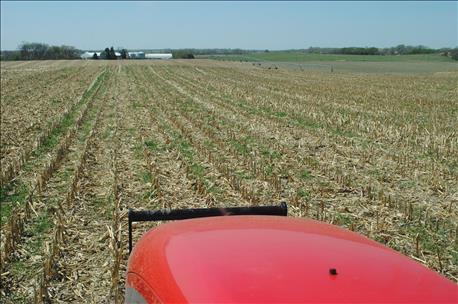
When I was planting years ago, I usually tried to stop for a noon lunch, even if it was out in the field, just to stretch my legs and check out the planter. Even with auto-steer and guidance systems, getting out to stretch your legs and inspect the machine regularly is still a good idea.
The bad thing about the noon time break was when I got started again, I usually had a sleepy spell between about 1 and 2 p.m. If I made it through that, I usually was good to go well into the evening.

VIEW FROM THE CAB: Long hours in the tractor cab can cause planting time fatigue.
Fatigue can be a problem that comes with long hours in the tractor starting early in the morning and going late into the night. Preventing or at least slowing fatigue is crucial for safety in operating equipment and in getting the job done without needless breakdowns, accidents or mistakes.
I like a recent United Soybean Board post about aspects that can become pitfalls and safety concerns if we aren’t paying attention. Here are a few from their list along with some of my own, from experience.
Transporting machinery safely. Bigger equipment means bigger challenges when getting things from the farm to the field and back again. If you live along a busy highway like I do, try to move equipment in daylight hours when motorists can see you. You can also schedule moves during times when there are fewer travelers on the road. We live along a well-travelled blacktop road that is a shortcut for boaters, campers and travelers to the lake. Moving equipment on a Friday evening was challenging because of the heavy recreation-minded traffic hurrying to get to their lakeside destination on a weekend. I avoided those times if I could.
Watch for power lines. Big equipment these days can also easily get tied up with power lines. Make turns in the field and around the farm carefully. Have someone else work with you as a spotter if you think your equipment will come even close to touching a power line.
Keep equipment maintained. I know you are hurried to get ahead of the latest rainstorm, but a few minutes in maintenance can ward off hours of frustration and more than a few colorful metaphors after a piece of equipment breaks down in the field. If you are like me, things never break down close to home. It always happens at the field farthest from the shop.
Related: Farming can be a real pain in the back
Watch your labels. Be sure you are planting the varieties you want where you want. Check every bag or batch carefully. If you are applying pesticides, always check with the label and follow it exactly. Handle pesticides safely, using safety clothing and gear when necessary.
Stay healthy. Get enough rest if possible. Have a thermos of coffee in the cab with you and take healthy snacks with you to keep you powered up along with your machinery. Take regular breaks to get fresh air, stretch your back and muscles and inspect the machinery.
Watch for children. If you have young children around where you are working, always be on the lookout and be sure to watch behind you and along the sides of the equipment before moving. Train children to stay away from a moving farm implement. Slow down and take your time.
Planting time is a crucial point in the growing season, so we want everyone to have a healthy, safe and break-down free planting season. And remember, be careful out there.
Be sure to follow the latest local farm news at Nebraska Farmer online or on our Facebook page.
About the Author(s)
You May Also Like






